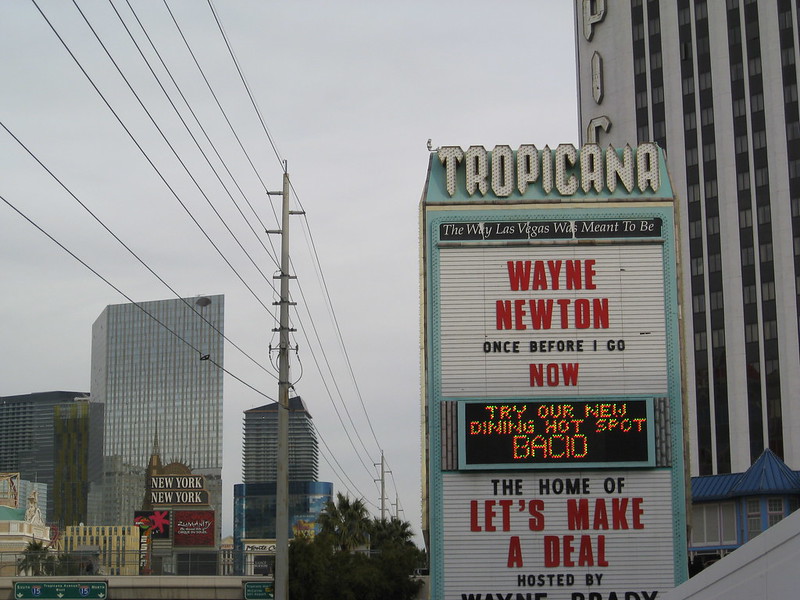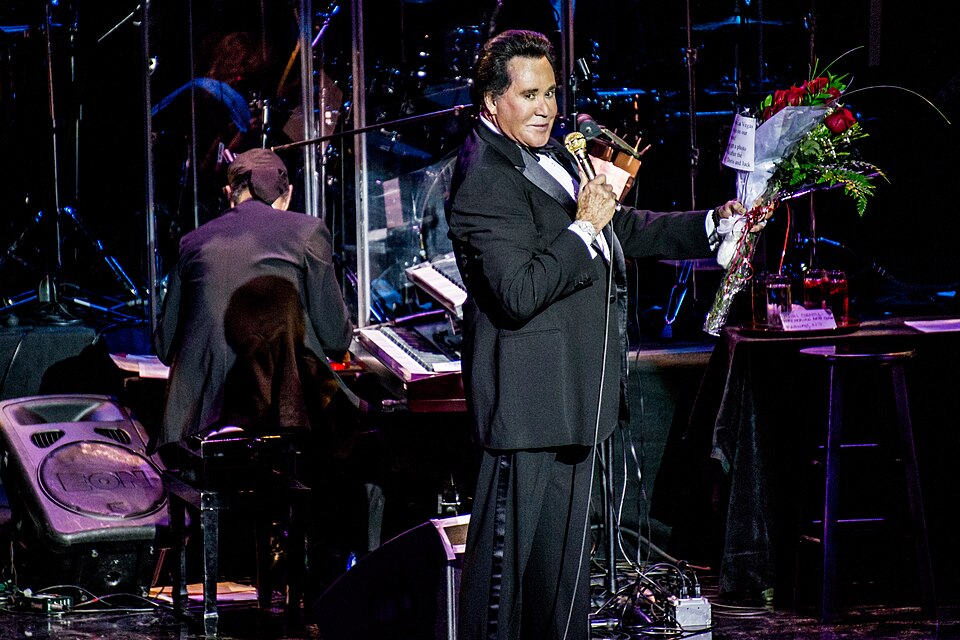Wayne Newton, a name synonymous with the dazzling allure of Las Vegas, once captivated a live television audience by singing “Danke Schoen” while riding a horse—an audacious blend of showmanship and charm that epitomizes his career. For over six decades, Newton has not just performed in Las Vegas; he has become its living pulse, earning the title “Mr. Las Vegas” through an unmatched blend of talent, tenacity, and devotion to the city. But what makes this man, born Carson Wayne Newton in 1942, more than just a performer? Why does his legacy continue to shine as brightly as the Strip’s neon lights in 2025? This is the story of a prodigy who became an icon, a performer who redefined entertainment, and a figure whose life is woven into the very soul of Las Vegas.
A Star Born Under Desert Skies
Wayne Newton’s journey to stardom began far from the glitz of Vegas, in Norfolk, Virginia, where he was born on April 3, 1942. Plagued by severe asthma, young Wayne faced health challenges that could have derailed his dreams. His family’s move to Phoenix, Arizona, seeking a drier climate, proved pivotal. There, Wayne and his older brother, Jerry, discovered their musical talents. By age six, Wayne was already performing, strumming a guitar and singing with a voice that hinted at the powerhouse it would become. The Newton Brothers, as they were billed, were a precocious act, blending country, pop, and charm that belied their youth.
By their early teens, the brothers were seasoned performers, appearing on local radio and television shows. Their big break came in 1958 when they landed a spot on The Lew King Rangers Show, a popular Phoenix program. A Las Vegas booking agent caught their act and offered them a two-week gig at the Fremont Hotel and Casino in 1959. At just 16, Wayne stepped onto a Vegas stage for the first time, unaware that those two weeks would stretch into a lifetime. The brothers’ blend of harmonies, humor, and multi-instrumental skills—Wayne reportedly mastered over a dozen instruments, including piano, banjo, and steel guitar—captivated audiences. What was meant to be a short stint turned into a six-month residency, with the duo performing up to six shows a day, six days a week. This grueling schedule forged Wayne’s work ethic and stage presence, laying the foundation for his future as a headliner.
The Voice That Launched a Legend
While the Newton Brothers built a loyal following, Wayne’s solo career ignited in the early 1960s. His high tenor voice, rich with emotion and versatility, caught the attention of producer Bobby Darin, who helped secure a recording contract. In 1963, at age 21, Wayne released “Danke Schoen,” a jazzy pop anthem that became his signature. The song’s infectious melody and Wayne’s earnest delivery propelled it to No. 13 on the Billboard Hot 100, introducing him to a national audience. Its use in films like Ferris Bueller’s Day Off decades later cemented its cultural staying power, but in the ‘60s, it was Wayne’s ticket to stardom.
Other hits followed, showcasing his range. “Daddy, Don’t You Walk So Fast” (1972) hit No. 4 on the Billboard charts, its heartfelt narrative resonating with listeners. “Red Roses for a Blue Lady” (1965) and “Summer Wind” (1965) highlighted his ability to reinterpret standards with a youthful flair. Yet, while his recordings earned him fame, it was his live performances in Las Vegas that transformed him into a phenomenon. Unlike many artists who balanced touring with Vegas residencies, Wayne made the city his primary stage, transitioning from lounge acts to headlining showrooms at legendary venues like the Flamingo, Sands, and Stardust.

Crafting the “Mr. Las Vegas” Persona
The title “Mr. Las Vegas” wasn’t bestowed overnight; it was earned through a combination of longevity, showmanship, and an almost mythic dedication to performance. By the mid-1960s, Wayne was no longer just a lounge singer—he was a headliner commanding the Strip’s most prestigious stages. His shows were a masterclass in versatility: he sang, danced, played multiple instruments, told jokes, and engaged audiences with a warmth that felt personal, even in packed showrooms. Critics noted his ability to make every guest feel like the only one in the room, a skill honed through years of relentless performing.
Unparalleled Longevity
Few entertainers can claim a career as enduring as Wayne Newton’s. From his Vegas debut in 1959 to his performances in 2025, at age 83, he has maintained a presence in the city for over six decades. While icons like Elvis Presley and Frank Sinatra had transformative Vegas runs—Elvis with his comeback residencies in the late ‘60s and Sinatra with his Rat Pack swagger—Wayne’s consistency sets him apart. Elvis performed roughly 837 shows in Vegas between 1969 and 1976; Sinatra’s residencies spanned decades but were intermittent. Wayne, by contrast, has logged an estimated 40,000 performances in Las Vegas alone, a staggering figure that underscores his dominance.
His schedule in the ‘60s and ‘70s was relentless: two to three shows a night, six nights a week, often 50 weeks a year. At the Desert Inn, he became a fixture, selling out the Crystal Showroom for years. Even as Vegas evolved—from the mob-run era to corporate mega-resorts—Wayne adapted, headlining at the MGM Grand, Caesars Palace, and Bally’s. His ability to remain relevant across generations, from post-war audiences to millennials, is a testament to his universal appeal.
Record-Breaking Performances
Wayne’s performance tally isn’t just a number; it’s a legend. By the early 2000s, he was widely reported to have performed over 30,000 shows in Las Vegas, a record unlikely to be broken. At his peak, he averaged 300 shows annually, each a high-energy spectacle lasting up to two hours. His stamina was remarkable, especially given the physical demands of singing, dancing, and playing instruments night after night. Fans flocked to see him, drawn by his reputation for never phoning it in. Whether performing for a sold-out crowd or a half-empty room during a weekday matinee, Wayne gave his all, a commitment that earned him respect from peers and adoration from audiences.

The Quintessential Vegas Showman
Wayne Newton embodied the Vegas ideal: a larger-than-life performer who could do it all. His shows blended pop, country, jazz, and standards, reflecting the city’s eclectic tastes. He wasn’t just a singer; he was an entertainer in the truest sense, weaving storytelling and humor into his act. His rendition of “Danke Schoen” often closed shows, with audiences singing along, but he also paid homage to Vegas’s history, covering Sinatra and Presley while adding his own flair.
His stage presence was magnetic. Standing at 6’2”, with a boyish grin and jet-black hair (later famously styled), Wayne commanded attention. He interacted with fans mid-song, shaking hands, cracking jokes, and even inviting audience members onstage. This accessibility set him apart from more aloof stars, fostering a loyalty that kept fans returning for decades. His shows were a microcosm of Vegas itself: glamorous, inclusive, and endlessly entertaining.
A Commitment to the City
Unlike many performers who treated Vegas as a gig, Wayne made it his home. In 1968, he purchased a modest ranch in Las Vegas, which he expanded into Casa de Shenandoah, a 52-acre estate that became a local landmark. Complete with Arabian horses, peacocks, and a private zoo, the property reflected his flamboyant personality and deep roots in the city. Though he sold parts of it in later years, Casa de Shenandoah symbolized his bond with Las Vegas, serving as both a residence and a tourist attraction.

Wayne’s commitment extended beyond his stage. He became an unofficial ambassador for Las Vegas, promoting its tourism and defending its reputation during controversies, like the mob-era scandals of the ‘70s. He supported local charities, performed at community events, and mentored young entertainers. His involvement in the USO, entertaining troops overseas, further endeared him to Americans, but it was his loyalty to Vegas that solidified his status as its leading man.
Beyond the Stage: The Man and the Myth
Wayne Newton’s life offstage is as colorful as his performances. His charisma made him a pop culture fixture, appearing on The Lucy Show, Bonanza, and later Roseanne. He starred in films like Licence to Kill (1989) as a villainous televangelist, showcasing his versatility. Yet, his personal life wasn’t without challenges. Financial troubles in the 1990s, including a high-profile bankruptcy filing, made headlines, but Wayne bounced back, proving his resilience. Rumors of mob ties, fueled by Vegas’s murky past, dogged him, but investigations found no evidence, and Wayne dismissed them with his trademark humor.
His love for animals, particularly horses, added another layer to his persona. At Casa de Shenandoah, he bred champion Arabian horses, a passion he shared with fans during estate tours. His patriotism, evident in USO tours and performances for presidents from Kennedy to Trump, resonated with audiences, reinforcing his all-American image.
Facing the Spotlight’s Challenges
Wayne’s career wasn’t immune to setbacks. The 1980s brought vocal strain from his punishing schedule, deepening his voice and prompting a shift to lower-key songs. Critics occasionally called his act old-fashioned as Vegas embraced newer stars like Celine Dion and Britney Spears. Yet, Wayne adapted, incorporating tributes to contemporary artists and maintaining relevance through nostalgia. Health scares, including a heart condition in 2007, slowed him briefly, but he returned to the stage with renewed vigor.
Controversies, like a 1980 defamation lawsuit against NBC over mob allegations, tested his resolve. Wayne won the suit, vindicating his reputation. Through it all, his fans remained loyal, drawn to his authenticity and refusal to bow to adversity.
An Enduring Legacy in 2025
As of April 2025, Wayne Newton, at 83, continues to perform, a living bridge to Vegas’s golden age. His current show, Wayne: Up Close and Personal, at the Flamingo’s Wayne Newton Theater, offers an intimate look at his life, blending hits with stories from his career. His voice, now a weathered baritone, carries the weight of experience, but his charisma remains undimmed. Fans, from lifelong devotees to curious newcomers, pack the room, proving his timeless appeal.
Wayne’s influence extends beyond his performances. He paved the way for modern Vegas residencies, showing artists like Elton John and Adele how to make the city a home. His work ethic inspired entertainers like Donny Osmond, who cites Wayne as a mentor. The Wayne Newton Theater, renamed in his honor, stands as a testament to his impact, as does his star on the Las Vegas Walk of Stars.
Why “Mr. Las Vegas”?
The moniker “Mr. Las Vegas” captures more than Wayne Newton’s talent—it reflects his soul-deep connection to the city. He didn’t just perform in Vegas; he lived it, breathed it, and shaped it. His 40,000-plus shows are a record of devotion, each one a love letter to his audience. He weathered cultural shifts, from the Rat Pack era to the EDM-fueled 21st century, remaining a constant in a city defined by change.
Other legends left their mark—Elvis with his charisma, Sinatra with his swagger—but Wayne’s longevity, accessibility, and community ties set him apart. He wasn’t a visitor passing through; he was Vegas’s adopted son, its ambassador, its heartbeat. His story is one of grit, glamour, and an unrelenting passion for performance.
A Living Legend
Wayne Newton’s legacy is Las Vegas itself—a city of dreams where a kid from Virginia could become an icon. His life mirrors the Strip’s evolution: bold, resilient, and ever-entertaining. As he takes the stage in 2025, he carries the torch for a bygone era while inspiring the future. To see Wayne Newton perform is to witness history, to feel the pulse of a city he helped define. He is, and will forever be, “Mr. Las Vegas”—the Midnight Idol whose light never fades.





